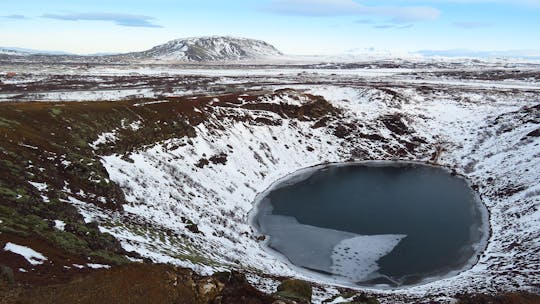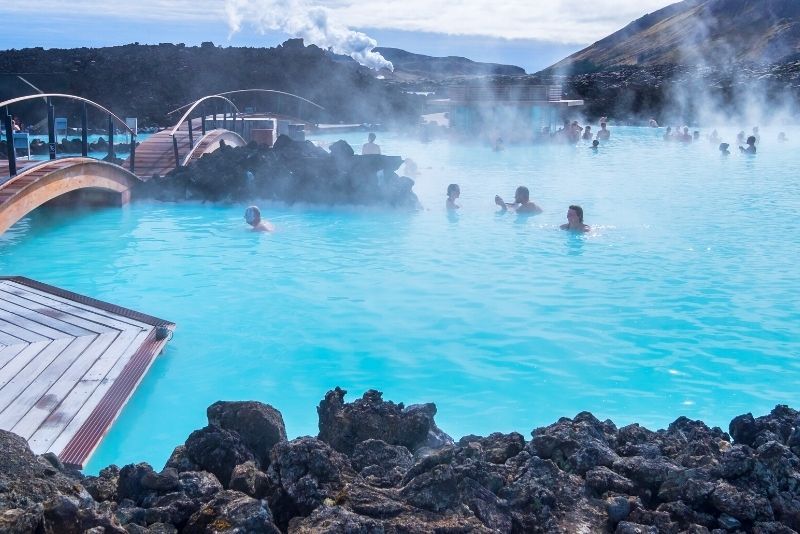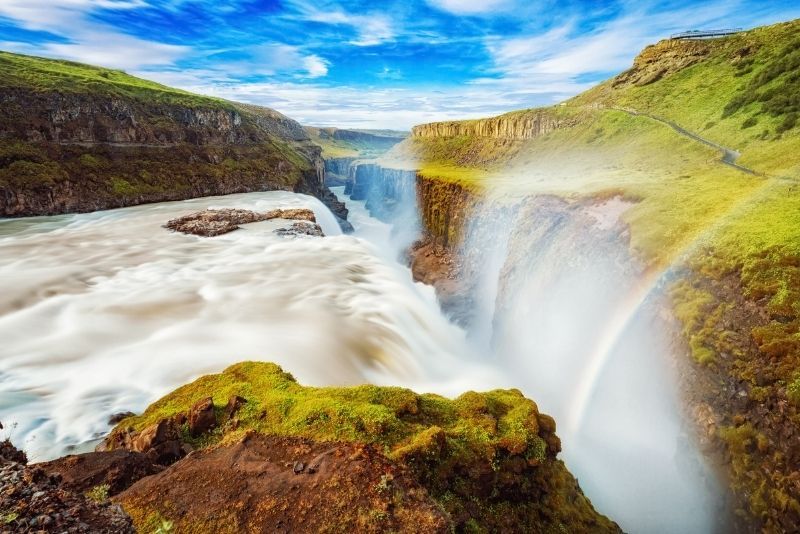Kerid Volcanic Crater: Day Trips and Tours from Reykjavík
If you're looking to explore the extraordinary landscapes of southern Iceland, look no further than Kerid Volcanic Crater. The unique red slopes of the caldera are covered in a thick blanket of lush vegetation and its vibrant blue lake reflects light like a mirror.
Visitors on a day trip to Kerid Volcanic Crater from Reykjavík can follow the trail around the volcanic rim and learn about how the caldera was formed thousands of years ago.
If you're looking to explore the extraordinary landscapes of southern Iceland, look no further than Kerid Volcanic Crater. The unique red slopes of the caldera are covered in a thick blanket of lush vegetation and its vibrant blue lake reflects light like a mirror.
Visitors on a day trip to Kerid Volcanic Crater from Reykjavík can follow the trail around the volcanic rim and learn about how the caldera was formed thousands of years ago.

(0/24) checking Musement...
If you're looking to explore the extraordinary landscapes of southern Iceland, look no further than Kerid Volcanic Crater. The unique red slopes of the caldera are covered in a thick blanket of lush vegetation and its vibrant blue lake reflects light like a mirror.
Visitors on a day trip to Kerid Volcanic Crater from Reykjavík can follow the trail around the volcanic rim and learn about how the caldera was formed thousands of years ago.

Here's all you need to know about Kerid Volcanic Crater, one of the most exciting day trips from Reykjavík.
How to get to Kerid Volcanic Crater from Reykjavík?
Kerid Volcanic Crater is located in the Grímsnes region of southwest Iceland. It is approximately 70 kilometers from the capital city of Reykjavík.
From Reykjavík to Kerid Volcanic Crater by car
The jaunt to Kerid Volcanic Crater takes around an hour by car. Leave the city in an easterly direction on Route 49 and then follow Þjóðvegur 1 as far as Selfoss. Merge onto Suðurlandsvegur and follow it to the crater.
Guided tour to Kerid Volcanic Crater from Reykjavík
If you don't have access to a car while on vacation, make your journey to Kerid Volcanic Crater via a guided excursion instead.
You'll benefit from a convenient hotel pickup service in the city and everything is taken care of for you. Your day trip will usually begin around 9 AM and last between 8, and 11 hours, depending on the route you choose.
How much does the entrance ticket to Kerid Volcanic Crater cost?
Each person must pay a small fee of ISK400 (US$3) to enter the Kerid Volcanic Crater. The money raised is used to protect and preserve the land surrounding the caldera.
What is the typical itinerary?

After traveling out of the city, most day tours to Kerid Volcanic Crater head toward Thingvellir National Park. Here, you can admire the vast open landscape and see where the North American, and Eurasian tectonic plates were forced apart.
From there, you'll continue on to the Geysir, which lies in the Haukadalur Valley and has been active for around 10,000 years.
Some tours also make a quick stop at the neighboring Strokkur geyser, which is extremely active and explodes every 7 to 10 minutes. Next, you'll visit the Gullfoss Waterfall before journeying to the main destination — Kerid Volcanic Crater.
Here, you can see the turquoise lake that sits atop the caldera and learn about its history as one of Iceland's newest volcanoes. Depending on the excursion you choose, your day trip to Kerid Volcanic Crater may end here.
Alternatively, some tours visit a farm to show the traditional day-to-day life of Iceland.
Others take a trip to the world-renowned Blue Lagoon for a well-deserved moment of relaxation before returning to Reykjavík where your Kerid Volcanic Crater day tour ends.
What kinds of tours are available?
Day tours to Kerid Volcanic Crater usually include several of Iceland's most diverse geological gems. Choose an excursion based on your personal interests.
Day tour to Kerid Volcanic Crater plus Golden Circle from Reykjavík
Traveling away from the bustling streets of the city, you'll be met with a tranquil and jaw-dropping landscape of Southwest Iceland.
Travel to the ancient Geysir, which spouts boiling streams of water into the air several times a day, before witnessing the roaring Gullfoss Waterfall up close.
Next, take a trip to Thingvellir National Park, where the North American and Eurasian tectonic plates separated in the 18th century, and are still drifting further apart today.
Lastly, imagine lava streams pouring out of the Kerid Volcanic Crater, which was formed 6,500 years ago.
Guided tour to Kerid Volcanic Crater plus Golden Circle and Blue Lagoon from Reykjavík

Taking your tour of Iceland's natural world one step further, you can choose an excursion that includes the iconic Blue Lagoon.
Spend your day hiking through the Thingvellir National Park, walking around the rim of the Kerid Volcanic Crater and watching the Gullfoss Waterfall tumble into the Hvítá River.
Then, rest your weary feet in the thermal waters of the Blue Lagoon and enjoy a pamper session amidst rock formations, and rolling hills.
Day trip to Kerid Volcanic Crater plus Fridheimar Farm and Golden Circle from Reykjavík
Alternatively, see Iceland's agricultural traditions at two different farms. You'll try handmade ice cream and meet the cows who helped produce it at a thriving dairy farm.
You'll also meet Icelandic horses and learn about cultivating tomatoes in the frigid country. Visit the human-made Öxarárfoss Waterfall, where the Icelandic parliament was first formed in the 10th century.
How much does a day trip to Kerid Volcanic Crater from Reykjavík cost?
A day trip to Kerid Volcanic Crater that includes the Golden Circle loop costs approximately US$70 per person. This price includes round-trip accommodation and a professional guide.
For US$120 per person, you can participate in a small-group day tour to Kerid Volcanic Crater that includes visits to traditional Icelandic farms.
You can select the most comprehensive tour, which includes the Blue Lagoon for between US$130 and US$210 each. Those on the higher end of the range include entry fees for the Kerid Volcanic Crater and the Blue Lagoon.
What will you see and do?

Kerid Volcanic Crater forms part of the Golden Circle, which is a loop made up of three of Iceland's most remarkable geological sites. These other landmarks are Gullfoss Waterfall and Thingvellir National Park — Iceland's only UNESCO-listed destination.
The crater is approximately 270 meters in circumference, 170 meters wide and 55 meters deep. One of the Kerid Volcanoes' most defining features is its red slopes leading to the crater lake on top.
While the majority of Volcanoes across the world are formed of black earth, Kerid's red coloring shows that it is much younger in comparison to others.
In fact, Kerid is approximately half the age of the surrounding Seyðishólar and Kerhóll volcanoes, at around 6,000 years old.
While most volcanic craters are formed by a giant eruption, Kerid has left no trace of this being the case.
Instead, it is believed that Kerid was originally a cone volcano, which collapsed internally, forming the caldera you see today. The lake atop the volcano is a striking shade of emerald, caused by minerals in the soil.
Although the caldera is steep, visitors can access the crater lake from one side of its slopes. While the water may look enticing, swimming is forbidden for the sake of public safety.
As a natural landmark, Kerid Volcanic Crater is open 24 hours a day, so many visitors choose to head to its caldera at night. This is because it is a prime viewing location of the Northern Lights.
When is the best time to visit Kerid Volcanic Crater?
The caldera is a spectacular sight in all climates meaning you can plan a day trip to Kerid Volcanic Crater at any time of year.
However, during the winter months, the slopes can become slippery, making the walk down to the lake dangerous. You may consider visiting between May and September if you wish to access the crater lake.
Travel tips
- Wear appropriate hiking boots on your Kerid Volcanic Crater day trip to avoid slipping on the slopes of the caldera.
- Plan to spend between 30 minutes and an hour at the crater.
- The maximum temperature around the caldera is 14 degrees during the summer months. Pack a spare thermal layer on your Kerid Volcanic Crater excursion in case you get cold.

